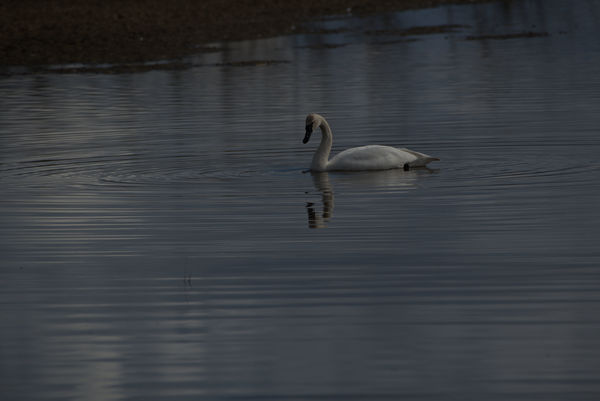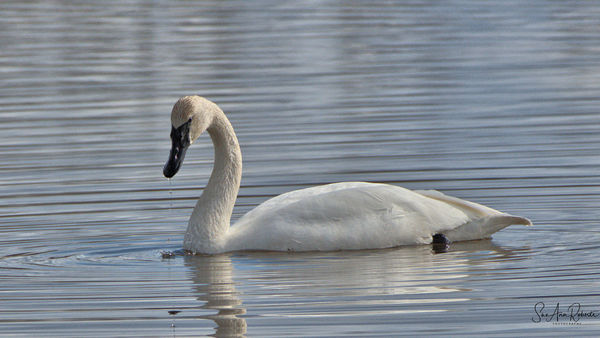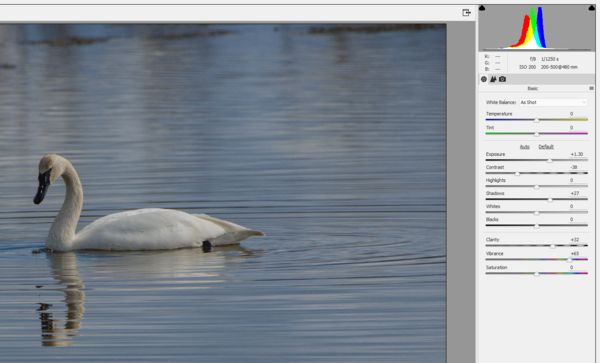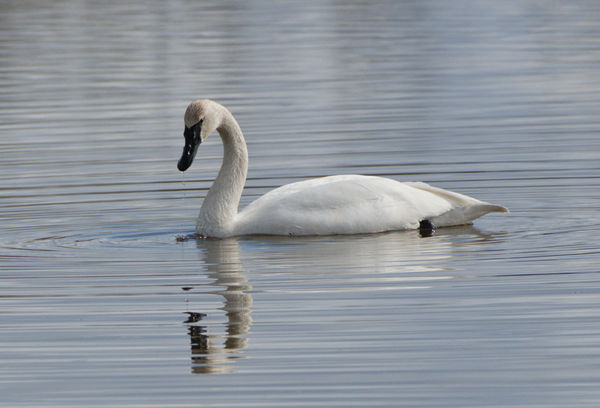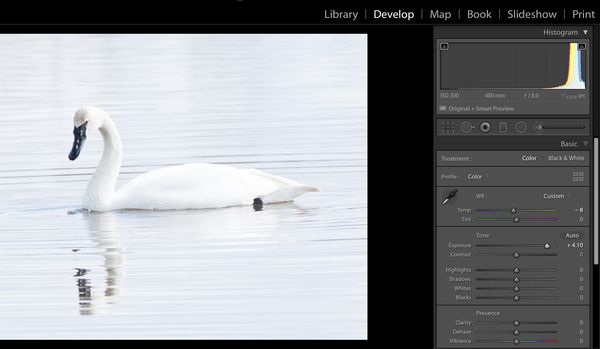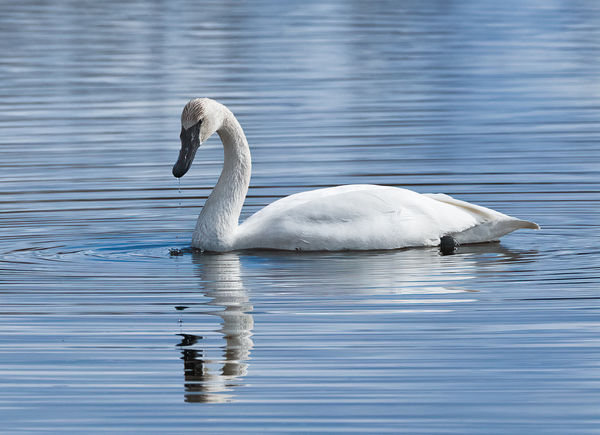Photographing White Wildlife - An Addendum
Apr 15, 2019 12:14:28 #
tiphareth51
Loc: Somewhere near North Pole, Alaska
Armed with the information provided so graciously by members here, I went out yesterday with hopes for a better swan photo. The inclusion of water droplets off the beaks of the ducks I photograph to me, adds to the image. So, this is the swan photo that I really like. I did dial in an exposure compensation and also a much lower ISO. A polarizer was also used to help deflect sun shimmer off the water. I do find the difference in white between the head and the body to be distracting. If anyone out there would care to provide post-processing suggestions, that would be greatly appreciated! My post-processing skills are significantly lacking in this area. Computer glare after cataract surgery is a problem so my work is done in small steps.
Thank you for your time and suggestions. Also, in keeping with forum rules, by posting here, I do grant permission for others to alter, enhance and repost this image.
Please note that due to difficulty resizing the raw file, it could not be attached*....my post-processing skills in raw are very bad...so an unedited jpeg image is included...sorry. Thank you!
*The first "download" link was your raw file. The system automatically assigns a caption with the words "attached file." It uploaded fine (they won't show a thumbnail); however, it appears you changed the file extension name. It was reading as .raw when it should be .nef
Do another upload of the original nef - but don't touch the file name or file extension. I have deleted the other. Looks like you squeezed in at just over the 20 mb limit
Linda
Thank you for your time and suggestions. Also, in keeping with forum rules, by posting here, I do grant permission for others to alter, enhance and repost this image.
Please note that due to difficulty resizing the raw file, it could not be attached*....my post-processing skills in raw are very bad...so an unedited jpeg image is included...sorry. Thank you!
*The first "download" link was your raw file. The system automatically assigns a caption with the words "attached file." It uploaded fine (they won't show a thumbnail); however, it appears you changed the file extension name. It was reading as .raw when it should be .nef
Do another upload of the original nef - but don't touch the file name or file extension. I have deleted the other. Looks like you squeezed in at just over the 20 mb limit

Linda
Apr 15, 2019 14:14:30 #
Learn to utilize your image editor's burn/dodge brush tool to amend the brightness for individual areas, rather than relying entirely on global adjustments to achieve the image you want. Although it will require some practice to master the burn/dodge brush tool, it will be well worth the effort.
Apr 15, 2019 18:46:18 #
In addition to rook's suggestion re selective dodge/burn, in your initial raw editing try lowering the contrast and raising the shadows. This will even out the exposure and make it easier for you to make selective adjustments later on in your process.
One example is below in a screenprint of the version of Adobe Camera Raw that comes with PS Elements. You may also find it helpful to lower highlights and/or whites and raise the blacks - depending on the scene.
One example is below in a screenprint of the version of Adobe Camera Raw that comes with PS Elements. You may also find it helpful to lower highlights and/or whites and raise the blacks - depending on the scene.
Apr 16, 2019 09:25:26 #
tiphareth51 wrote:
Armed with the information provided so graciously ... (show quote)
How about supplying your camera and exposure information so we do not have to look it up? If the first picture is merely the jpg of the raw, you are still a good two stops underexposed. What exposure mode are you using? If you are in manual, that might be the problem. Are you checking the viewer to make sure your exposure is good?
Raw files. You cannot make them smaller, brighter or anything else. Your software does that and then you share the results, typically as a jpg. You can share the larger raw's by uploading them to something like dropbox. And, as Linda says, never, ever change the extension. That is a property of the file type and only software can change file type and, by extension, the extension. Excuse the pun.
As for the polarizer, it works when you have bright, direct sun which is, optimally, parallel to the sensor plane, and when rotated to maximize the polarization. When all three of these conditions are met, then the filter works. Otherwise, you just lost about two stops of exposure. It also works better at mid-day than in the golden hours. From this shot, I cannot tell if using it was appropriate.
People share the misconception about processing raw's as you stated here. The only difference you really notice is that you have more exposure latitude and better colors than with jpg's. Otherwise, you do all the same things but with better results. I missed one other thing. You share the results of editing raw's by exporting them while the actual raw remains completely unaltered.
Final issue. Having a longer lens would help a lot. To get your final picture, you cropped a lot and that degrades image quality. I know cropping is cheaper than buying a new lens and also a lot lighter but you might want to add something like a 150-600 to your wish list. I did not look to see what lens you used here so this comment might be irrelevant. Also, I suggest using a tripod and an aperture two stops down from wide open.
I hope these comments help and you will go out there again for another try.
Apr 16, 2019 10:45:42 #
(One quick note for those who don't want to wade through the rest  Setting exposure compensation, or adjusting manual exposure, for high-contrast scenes requires practice. Per the below, the OP would not have had to make an adjustment in this case, but against a darker background, it would certainly be appropriate. There's no substitute for experience, bracketing, and analyzing results.)
Setting exposure compensation, or adjusting manual exposure, for high-contrast scenes requires practice. Per the below, the OP would not have had to make an adjustment in this case, but against a darker background, it would certainly be appropriate. There's no substitute for experience, bracketing, and analyzing results.)
https://www.get-metadata.com/
For exif viewing, this site is quick and easy and doesn't require your passing the "I am not a robot" test, which I invariably fail
f/8, 1/1250 sec, ISO 200, 480 mm on 200-500 mm lens, aperture priority with -1 EC.
I don't know if it's possible, without information from the OP, to know how much the polarizer affected exposure; however, in checking the histogram in PS Elements ACR, I could easily take the image 2 stops lighter without losing detail in the swan. The question is where to gain the two stops without lowering shutter speed or changing aperture. In this case change ISO to 100 and set EC back to zero.
This flexibility with exposure is important to know, because when shooting wildlife you have to prioritize and you often have to make decisions quickly if you're going to capture the moment.
IMO the most important is a fast enough shutter speed to prevent motion blur. #2 is aperture for the depth of field you desire. Using this calculator will help decide appropriate aperture: the further away you are, the more dof you can enjoy at a given f/stop.
Steve Perry's name came up in the thread posted to Analysis. His website is
https://backcountrygallery.com/
And his UHH user account is
https://www.uglyhedgehog.com/user-profile?usernum=60547
He has topics and links posted to UHH + many e-books on his website for those wishing to explore further, including when to use auto ISO and when to use burst mode. He is a great resource for this forum!
.
 Setting exposure compensation, or adjusting manual exposure, for high-contrast scenes requires practice. Per the below, the OP would not have had to make an adjustment in this case, but against a darker background, it would certainly be appropriate. There's no substitute for experience, bracketing, and analyzing results.)
Setting exposure compensation, or adjusting manual exposure, for high-contrast scenes requires practice. Per the below, the OP would not have had to make an adjustment in this case, but against a darker background, it would certainly be appropriate. There's no substitute for experience, bracketing, and analyzing results.)abc1234 wrote:
How about supplying your camera and exposure information so we do not have to look it up? ....
https://www.get-metadata.com/
For exif viewing, this site is quick and easy and doesn't require your passing the "I am not a robot" test, which I invariably fail

f/8, 1/1250 sec, ISO 200, 480 mm on 200-500 mm lens, aperture priority with -1 EC.
I don't know if it's possible, without information from the OP, to know how much the polarizer affected exposure; however, in checking the histogram in PS Elements ACR, I could easily take the image 2 stops lighter without losing detail in the swan. The question is where to gain the two stops without lowering shutter speed or changing aperture. In this case change ISO to 100 and set EC back to zero.
This flexibility with exposure is important to know, because when shooting wildlife you have to prioritize and you often have to make decisions quickly if you're going to capture the moment.
IMO the most important is a fast enough shutter speed to prevent motion blur. #2 is aperture for the depth of field you desire. Using this calculator will help decide appropriate aperture: the further away you are, the more dof you can enjoy at a given f/stop.
Steve Perry's name came up in the thread posted to Analysis. His website is
https://backcountrygallery.com/
And his UHH user account is
https://www.uglyhedgehog.com/user-profile?usernum=60547
He has topics and links posted to UHH + many e-books on his website for those wishing to explore further, including when to use auto ISO and when to use burst mode. He is a great resource for this forum!
.
Apr 16, 2019 23:59:39 #
tiphareth51 wrote:
Armed with the information provided so graciously ... (show quote)
Hi Sue Ann,
I'm coming back into this discussion a little late. I read Linda's and abc1234's responses. They give excellent advise.
I again looked at your new image posted using LR. LR is very similar to ACR in PSE. While the visual details of the swan begin to fade at about +2 stops, you had over +4 stops before you started clipping the highlights on the swan. I've attached the LR histogram to illustrate.
The exif data indicates you used matrix metering for your exposure. Usually this is OK, but in this case it looks like it is underexposing your images. You might try center-weighted or highlight-weighted to see if it will better expose your subject, such as this swan.
I see the time of day is early afternoon so the sun was fairly high in the sky. I would have expected more specular reflection off the water, so I assume the polarizer had a beneficial effect on this image.
No highlights or shadows were clipped so all the data is available for editing. But, since there's no information in most of the right side of the histogram, the jpg is effectively reduced from an 8-bit image to about a 5-bit image. This is where problems with banding during PP can occur. So is there enough data in the jpg to recover the details without banding or significantly amping up the noise?
From your original jpg, I increase the exposure +2 stops, cropped and corrected the white-balanced. Used AI Clear to increase sharpening and decrease noise. Applied a mask to the swan and increased clarity to help bring out more detain in the bird without clipping the highlights, especialy on the swan's back.
Working with the raw file would likely have yielded better results. While these results might not be acceptable for a 24x36" print, I think it looks pretty good on a 27" monitor. What do you think? You should be able to get a fairly good image from your raw file.
Mike
Apr 20, 2019 01:42:43 #
tiphareth51
Loc: Somewhere near North Pole, Alaska
I wish to personally thank everyone who responded to my two Photographing White Wildlife posts. Your willingness to help me learn and the expertise you graciously provided are very appreciated. This includes Linda from Maine, l-fox, Salvage Diver, luvmypets, abc1234, rook2c4. Hopefully I did not inadvertently miss anyone.
Now that I am half way through Steve Perry's latest book, Secrets to Exposure and Metering for Nikon along with your help, my knowledge of how to deal with these types of photos has been greatly improved.
Happy Spring!
Now that I am half way through Steve Perry's latest book, Secrets to Exposure and Metering for Nikon along with your help, my knowledge of how to deal with these types of photos has been greatly improved.
Happy Spring!
Apr 20, 2019 08:26:25 #
tiphareth51 wrote:
Thanks for checking back in, Sue. All the best on your journey - and don't be a stranger I wish to personally thank everyone who responded ... (show quote)

If you want to reply, then register here. Registration is free and your account is created instantly, so you can post right away.
